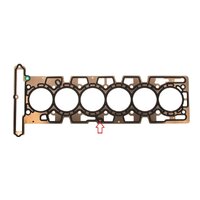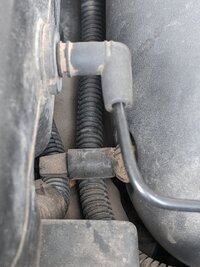Interesting however, riddle me this Batman,
- Why have the engineers programmed the PCM with built-in time based adjustments for the throttle body getting dirty? They knew that there would be some blow by coming back up that hose to the resonator and into the throttle body. The flaw with this system is when the battery is disconnected, it loses that adjustment and reverts to settings for a clean throttle body and causes idle issues.
- Although true that the PCM prevents the throttle from opening completely while in Park or Neutral, it will fully open to WOT while driving when commanded. At that point, there will be little to no vacuum and the blowby will overcome that low vacuum and some of it, along with some oil mist, will get into the resonator and throttle body.
There was a fair bit to read in this thread but apart from post #16 that incorrectly said that air should be coming out of that hose all the time (i.e. the resonator is the vacuum source), the rest is fairly accurate.
It's not a bad idea to clean that hose once in a while so it doesn't get plugged like the OP.
Well --- you got most of that wrong.
There was no real programming for oil getting into the throttle body since the ONLY thing the throttle body should EVER see was clean air from the air filter. Clean air -- only!
If service to this "non-existing" PCV system isn't performed on a regular basis - it will sludge up and then that crystalizes and forms a really hard crust that is pretty much non-destructible.
That nipple with the metered hole is always flowing inward - sucking air, if you will, from the air filter and into the valve cover and then it sweeps the crankcase and that contamination is then sucked into the intake runners to go through combustion and out the tailpipe. Easy-peasy.
The reason for the metered hole is to keep the crankcase from ever going neutral or positive and losing the PCV effect. If the intake is very small (eg: a restriction" or why, ask yourself, is it a very small hole? Huh? Riddle me THAT!) --- and vacuum/suction is supplied at the other end -- there is always going to be an atmospheric difference - ergo: a vacuum all the time.
√ That's the way it's SUPPOSED to be anyway.
Federal Motor Vehicle Law and Air Quality Standards will not allow it to be otherwise. ALL vehicles will be equipped with a POSITIVE CRANKCASE VENTILLATION SYSTEM, CAPABLE OF REMOVING BLOWBY AND FUMES AND VAPORS. DOUBLESTOP.
Anything more (or less) is categorically wrong.
The MAP senses that there is either sufficient or insufficient vacuum in the plenum behind the butterfly and adjusts the throttle opening to compensate up to it's limitation or capability while still staying in-program.
Perhaps you interpreted that
↑ as an engineer with his crystal ball, deciding how this system would be ignored and ultimately fail. Not likely, nor is any assumption drawing to a false conclusion.
It will always report that value - vacuum or pressure.
Vacuum = GOOD
Pressure = BAD.
Binary -
Boolean -
Logical.
The problem as I see it is that people don't realize the system is slowly plugging up until it's very late and it's when the baby poop starts flowing up under the oil cap, all over the dipstick and the VVT fails and then the constant advice to "clean the throttle body" starts coming around like flying monkeys as a cure.
Hell --- most owners and philosophers totally deny that a PCV system even exists on the 4.2L engine. Imagine that they think world is probably flat too.
Well --- that and "disconnect the battery to call the angels in for a miracle".
Disconnecting the battery is always bad advice for multi-many reasons of which I am not venturing on this date.
When the baby poop flows - it becomes a process of repairing the contamination and getting it to at least a modicum of operability to satisfy the computers.
As a "for instance" - my TB arrived with a large dose of baby poop and a Pampers-full sound chamber. It took me a few weeks to get the CV-side to operate at all ... and guess what?
No more baby poop.
I also now have a lot snappier throttle response and acceleration and it is black-n-white.
When the system can operate at a reasonably close to designed-in values --- things run so much better --- but like gray hair and memory loss - it insidiously arrives on cat-like feet and it just screws things up -- slowly.
EDITED because my spell checker likes to make new words on me and delete consonants and change them to obscura.



 This is the first time I've seen a confirmed case that it was clogged. Could be an easy and worthwhile "preventative maintenance" check for all of us.
This is the first time I've seen a confirmed case that it was clogged. Could be an easy and worthwhile "preventative maintenance" check for all of us.